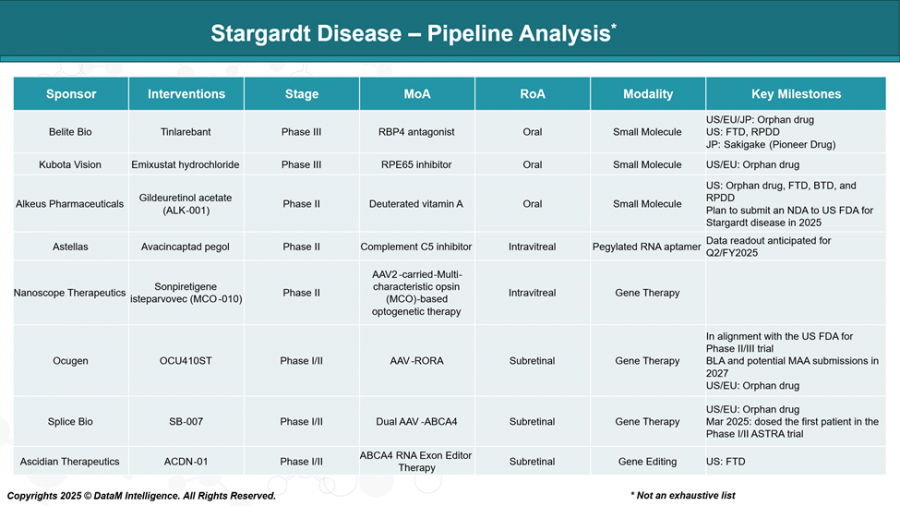
Stargardt Disease: Illuminating Hope Through Innovation and Resilience | Competitive Intelligence
Innovative gene and oral therapies signal a turning point for Stargardt disease, offering patients hope for preserved vision and improved quality of life.
AUSTIN, TX, UNITED STATES, May 29, 2025 /EINPresswire.com/ -- Stargardt disease, a rare inherited form of macular degeneration, is gaining attention as advancements in research and inspiring personal stories bring new hope to those affected.
Understanding Stargardt Disease
Stargardt disease, also known as juvenile macular dystrophy, is the most common form of inherited macular degeneration, affecting approximately 1 in 8,000 to 10,000 individuals worldwide. It typically manifests in childhood or adolescence, leading to progressive loss of central vision while often sparing peripheral vision. The condition is primarily caused by mutations in the ABCA4 gene, which leads to the accumulation of toxic fatty substances in the retina, damaging photoreceptor cells.
Book You CI Consultation Call for Free: https://www.datamintelligence.com/strategic-insights/sample/stargardt-disease
A Personal Journey: Tilly Hayward's Story
Seventeen-year-old Tilly Hayward from Peterborough, UK, embodies the resilience of those living with Stargardt disease. Diagnosed at age nine, Tilly has experienced a gradual decline in her vision, with recent assessments indicating that her peripheral vision is also deteriorating. Determined to experience the world before losing her sight completely, she has launched a fundraising campaign to visit destinations like Disneyworld in Florida and the beaches of Dubai.
Tilly's proactive approach includes studying psychology online, learning Braille, and advocating for awareness about visual impairments. Her story highlights the importance of early diagnosis, support systems, and the human spirit's capacity to adapt and thrive despite challenges.
Ask for Free Sample of Stargardt Disease CI Insights: https://www.datamintelligence.com/strategic-insights/ci/stargardt-disease
Advancements in Research and Treatment
While there is currently no cure for Stargardt disease, recent research offers promising avenues for treatment:
• Gene Therapy: Clinical trials are exploring gene replacement strategies to introduce functional copies of the ABCA4 gene into retinal cells. Early-phase studies have demonstrated safety, with ongoing research focusing on efficacy in slowing disease progression.
• Pharmacological Approaches: Gildeuretinol acetate (ALK-001), an oral therapy developed by Alkeus Pharmaceuticals, has shown potential in slowing the accumulation of toxic retinal byproducts. Clinical trials have indicated a significant reduction in the progression of retinal lesions in patients with advanced Stargardt disease.
• Emerging Therapies: Tinlarebant, an oral treatment by Belite Bio, aims to reduce the accumulation of vitamin A-based toxins in the retina. Currently in Phase III clinical trials, it has received Fast Track Designation and Orphan Drug Designation in the U.S., Europe, and Japan.
These developments signify a shift towards targeted therapies that address the underlying genetic and biochemical causes of Stargardt disease, offering hope for effective treatments in the near future.
Living with Stargardt Disease
Managing Stargardt disease involves a combination of protective measures and adaptive strategies:
• Sun Protection: Wearing sunglasses with UV protection and wide-brimmed hats can help shield the eyes from harmful rays, potentially slowing disease progression.
• Vision Aids: Utilizing low vision aids and participating in vision rehabilitation programs can enhance quality of life by maximizing remaining vision.
• Support Networks: Connecting with organizations like the Foundation Fighting Blindness provides access to resources, support groups, and information on the latest research developments.
About DataM Intelligence:
DataM Intelligence 4Market Research LLP is a leading provider of Competitive Intelligence (CI) services, empowering life sciences and healthcare companies with real-time, actionable insights. We specialize in tracking competitor strategies, pipeline developments, clinical trials, regulatory updates (FDA/EMA), and market trends across key therapy areas and indications.
Our offerings include CI insights, commercial analytics, opportunity analysis, KOL overviews, pricing and reimbursement strategies, social media listening, brand/LCM strategies, and market entry assessments. We also offer in-house tools, clinical trial databases, newsletters, and conference coverage to support your strategic decision-making.
With deep industry expertise and a commitment to timely intelligence, we help you stay ahead in a fast-evolving global market.
Read Our Related CI Reports:
1. Neurofibromatosis Type 1 | Competitive Intelligence
2. Gauchers Disease | Competitive Intelligence
Sai Kiran
DataM Intelligence 4market Research LLP
877-441-4866
email us here
Visit us on social media:
LinkedIn
X
Distribution channels: Healthcare & Pharmaceuticals Industry
Legal Disclaimer:
EIN Presswire provides this news content "as is" without warranty of any kind. We do not accept any responsibility or liability for the accuracy, content, images, videos, licenses, completeness, legality, or reliability of the information contained in this article. If you have any complaints or copyright issues related to this article, kindly contact the author above.
Submit your press release
